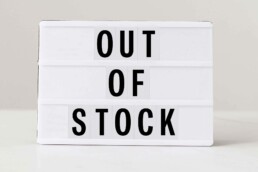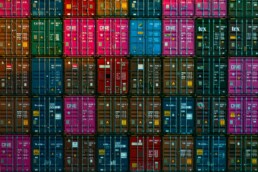The Environmental Impact of E-commerce: Part 1
Ready for part two? Read it here!
Key Points from Part Two:
- E-commerce transportation contributes to the largest cause of greenhouse gas emissions
- Learn how to reduce GHG emissions caused by e-commerce transportation
- E-commerce shipping materials account for more than 30% of annual waste
- Learn how eliminate unnecessary materials and reduce package waste
As e-commerce becomes the new normal for what was once primarily traditional brick-and-mortar experiences, rising e-commerce concerns are capturing the attention of shoppers and businesses alike. Although there are many concerns, we will focus on four environmental impacts of e-commerce that have emerged in recent years and what steps you can take to reduce these impacts.
PROBLEM
E-commerce Pays Significant Contribution to the Largest Cause of GHG Emissions
Together, FedEx and UPS deliver over 34 million packages every single day. Combine that with thousands of private truckers, shipping carriers, planes, ships, and freights. This makes up a considerable amount of the 29% of GHG emissions attributed to the transportation sector.
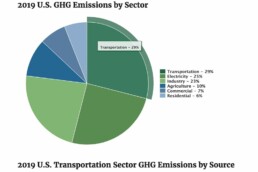
Image credit to EPA
For each gallon of fuel used by a common delivery van, about 22 pounds (10 kilograms) of CO2 is released into the atmosphere. Therefore, a delivery carrier traveling over 5,100 miles a year to fulfill next-day orders results in an annual 8 metric tons of CO2 for an average delivery van.
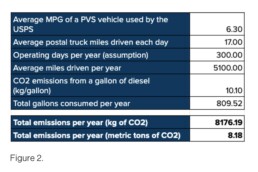
Photo credit to GlobalCurrent.com
The impact of e-commerce transportation will continue to expand. With consumer demand steadily increasing, e-commerce is expected to reach over $6 trillion in sales by 2024. This means we will likely see increased energy consumption, expanded infrastructure, and additional traffic due to delivery providers and fulfillment agencies.
SOLUTION
Combat Greenhouse Gas Emissions by Utilizing Alternative Delivery Options
Use Multiple Fulfillment Center Locations
Whether you’re investing or you choose to partner with a 3PL provider, utilizing multiple fulfillment locations helps your e-commerce reach customers faster, regardless of their location. When your e-commerce has multiple distribution centers, the time it takes for orders to reach customers is reduced and pick-up options become more convenient for shoppers.
Pick-up Points
Pick-up points range from storefront locations and public parcel lockers to picking up from participating partners like the local grocery store. These options allow customers to choose locations based on their needs, schedule and reduce the need for commercial product delivery.
Sustainable Carrier Programs
Popular shipping carriers like UPS and FedEx are now offering low-emission delivery vehicles, bicycle deliveries, and other efforts toward carbon offsetting and reducing GHG emissions. By partnering with carriers who have a focus on sustainability, you gain eco-friendly credibility for your e-commerce company not just in the eyes of shoppers but for the planet too.
Purchase Carbon Offsets
Carbon offsets are great options for reducing vehicle GHG emissions – or any kind of pollution for that matter. Firstly, by determining how much CO2 your company emits a year, you can become carbon neutral by purchasing carbon offsets. Straightaway, these programs reduce your carbon footprint without making drastic changes to your company’s operations or structure.
PROBLEM
The E-commerce Industry is Creating a Massive Cardboard Footprint
During a 2018 EPA study, out of 82,000 tons of containers, packaging, and shipping materials, only half were recycled, resulting in over 30,000 tons of landfill waste. This accounts for over 30% of the total annual waste in the US.

Image credit to EPA
A noticeable amount of e-commerce packaging waste comes from:
- A lack of space efficiency
- Poor vehicle consolidation
- Impulse shopping habits from consumers
- Excessive packaging
- Non-recyclable material
By using right-size boxes, bundling orders, and filling up all available space in delivery carriers, your e-commerce can reduce transportation emissions. Consequently, this approach decreases travel time and the number of trips needed to fulfill orders.
SOLUTION
Improve Packaging Procedures and Switch to Sustainable Materials
Reduce Unnecessary Packaging
Right-size packaging is important when reducing your package and material waste. Undoubtedly, by utilizing the right-size shipping containers according to individual product sizes, you eliminate unnecessary room and the need for extra packaging filler. With less room to move around, items are tightly secured and have a lower chance of being damaged, while safely making it to your customers without the extra wasteful material.
Make Packaging Recyclable, Reusable, or Biodegradable
Investing in recyclable materials helps your e-commerce make a greener impact even after orders have left your hands. Providing customers with less packaging and recyclable material, shoppers are able to contribute to a positive environmental impact by following the recycling directions.
For companies looking to deliver a more creative approach, integrating reusable purposes into product packaging reduces waste while also providing your customers with additional ways to enjoy your brand. Consider reusable packaging ideas like:
- Packaging that can be re-purposed into product holders.
- Shipping boxes that can be re-purposed into a cardboard castle for cats.
- Packaging that can be re-purposed as hangers or for product organization.
Another great option is to make your e-commerce and shipping packaging biodegradable. In this case, whatever material does make it to your customer, you won’t have to rely on them to recycle or reuse. Shoppers can dispose of packaging and waste will take less than 180 days to fully decompose when appropriately sent to an industrial facility.
Take Sustainability Seriously
From GHG emissions to a massive cardboard footprint, the environmental impacts of e-commerce are real and important for consumers and businesses alike to consider. Furthermore, knowing that e-commerce transportation contributes to the highest cause of GHG emissions and is responsible for 5 billion pounds of annual landfill waste underscores the urgency to shift to sustainable practices. Fortunately, we can reduce the global environmental impacts of e-commerce by utilizing alternative delivery options such as delivery pickup points and 3PL partners, as well as combat landfill waste by switching to smaller boxes and sustainable packaging materials.
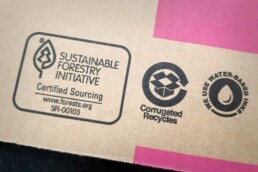
Eliminate Waste
Say goodbye to small items being shipped out in enormous packaging. At Falcon Fulfillment, we reduce waste by designing custom boxes that exactly fit your products. Consequently, this approach minimizes and, in many cases, eliminates the need for plastics and fillers.
- Eliminate up to 80% of waste with customers packaging
- Remove the need for plastic with boxes made for your product
- Combined orders to one package for reduced carbon footprint and waste
Beginner’s Guide to Third-Party Logistics (3PL)
The world of e-commerce is always changing, therefore understanding the roll of Third-Party Logistics is needed to keeping up. In light of this our beginner’s guide to third-party logistics (3PL) will delve into the essential aspects, offering insights into fulfillment services, warehousing, and much more.
Read More…
Take a step toward sustainability and talk with one of our agents today. Not only can we deliver the one-of-a-kind experience you’ve created for your loyal customers, but we can deliver it with minimal negative environmental impacts.
Make sure your customers know the planet is important to you and partner with Falcon today!
Let’s Talk!
How Inflation is Impacting E-commerce
How Inflation is Impacting E-commerce
Inflation is on the rise, and e-commerce businesses are feeling the uncertainty. According to Pew Research, inflation is 8.6%, the highest since 1981. American consumers haven’t seen this kind of inflation increase in four decades. With the fed raising interest rates, capital investments and consumer spending are drying up. This unsteady economic climate is causing more panic than preparation. The main contributors to the inflationary period are continued supply chain issues, the Russian/Ukrainian crisis, and new COVID-19 lockdowns in China. Knowing how inflation impacts e-commerce can help determine strategies to maintain profits and minimize spending.
Russian/Ukrainian Conflict

When Russia invaded Ukraine on February 24, 2022, inflation was already up 7.5%. However, a few critical events pushed that number higher and directly affected gas prices. Russia is one of the world’s largest producers of gas and oil. Therefore the conflict alone would have had a direct impact on fuel. President Biden banned imports of Russian oil shortly after the invasion, which increased fuel costs for American consumers. The knock-on effect of high-fuel costs is evident not just at the pump, but we are starting to see it directly impacting e-commerce.
Amazon added a 5% fuel inflation charge for its fulfillment clients in April of 2022. Subsequently, every consumer good that Amazon fulfills has a 5% upcharge based on the sustained high-fuel costs. There doesn’t appear to be relief either. E-commerce business owners will likely have to absorb the increased fuel surcharges or pass them along to consumers.
Supply Chain Pains

Thanks to the COVID-19 pandemic, we experienced a massive increase in demand for online goods. The rise in demand aligned perfectly with a supply chain bottleneck caused by a lack of laborers in the transportation and fulfillment network. Truck driver shortages are at an all-time high. The shortages have remained even with an increase in wages in America and Europe.
This labor shortage is also being seen in the ports and other transportation-focused industries. Goods are being held for longer because there aren’t people to move them to their final destination. Recent relief in the bottleneck is primarily attributed to lower demand. However, industries like household goods, food, and vehicle-related products are still experiencing high demand and slow fulfillment. The supply chain is recovering but at a snail’s pace.
COVID-19 Lockdowns in China

Chinese imports account for 18.6% of the overall imported goods consumed in the United States. The impact of recent lockdowns and stay-at-home orders sweeping across the Shanghai region of China will have a negative effect on inflation. The shipping container backlog will continue, and the pressure to get goods and component parts out of China.
Inflation is impacting e-commerce. What to do?
Clearly, inflation is harming e-commerce. With a very dismal forecast for inflationary change, what can be done? The first thing is to save more capital investment. While you can still generate capital investment, do it. As the FED threatens to raise rates, it is critical to have as much revenue in savings as possible. This gives your e-commerce flexibility in an uncertain market.
The second is to stockpile goods. Inflation is projected to continue rising, so the more raw materials and goods you can stock and store, the better your position will be in the near future. Lastly, Be prepared for continued changes in the inflationary climate.
Beginner’s Guide to Third-Party Logistics (3PL)
The world of e-commerce is always changing, therefore understanding the roll of Third-Party Logistics is integral to keeping up. In light of this our beginner’s guide to third-party logistics (3PL) will delve into the essential aspects, offering insights into fulfillment services, warehousing, and much more.
Read More…
There’s no crystal ball, but we can create inflation-hedging strategies based on current information. Falcon Fulfillment has solid relationships across multiple industries that we leverage to help our e-commerce clients find success. We are keeping a close eye on how inflation is affecting our clients and can get things moving when others fall short.
Regardless of how your business addresses high inflation, Falcon Fulfillment can help streamline your fulfillment process and ensure your company is best positioned to endure this economic storm. Reach out to an agent today.
Let’s Talk!
Beginners Guide to 3PL Fulfillment
Beginners Guide to 3PL Fulfillment
To help you evaluate whether or not a 3PL partnership is right for you, we have developed this beginners guide to 3PL fulfillment. We will discuss what a 3PL is, the pros and cons of using a 3PL, and questions you should ask before selecting a partner.
What is a 3PL

Third-party logistics, or 3PL for short, is a company that offers outsourced logistics services. 3PL services encompass everything from procurement to last-mile delivery. A 3PL provides the staff, space, and transportation network required for order fulfillment. They can manage receiving, inventory warehousing, packaging, and shipping services, letting businesses focus on other essential areas of their company. Some 3PL businesses offer additional logistics services known as value-added services. These include inventory management, kitting and assembly, and more. Furthermore, some 3PL companies specialize in specific product types such as:
- B2B
- Ecommerce
- Retail
- Apparel
- Health & Beauty
- Frozen Foods
- Nutraceuticals
- Beer & Wine
Pros of Working with a 3PL
In this beginners guide to 3PL fulfillment, we will focus on the most relevant benefits, although there are many more.
Industry Expertise
Streamlining and managing supply chains, transportation, and new market compliance can be overwhelming. When partnering with a 3PL, you gain the advantage of industry experts with insider knowledge. They can help facilitate imports, exports, international shipping compliance, and economic regulations. This is incredibly valuable as you consider launching new markets or expanding overseas.
Cost Savings
Businesses often partner with 3PLs to save money and boost profitability. 3PLs consistently improve efficiency in the order fulfillment process. They reduce shipping costs by leveraging their collective order volumes to negotiate better rates. Furthermore, they typically provide faster delivery times.
Scalability
Another benefit is the ability to scale your business with a 3PL. It is easier to navigate sales peaks and valleys when warehousing, staffing, and transportation needs rise and fall in step with demand. 3PL fulfillment companies give their clients the ability to scale quickly without significant capital investment in fulfillment infrastructure.
Customer Satisfaction
Working with a 3PL can significantly improve your overall customer satisfaction. They help provide quicker delivery options with more consistent results. The inventory management technology used by most 3PLs allows for fewer stock-out situations. Lastly, many 3PL companies handle reverse logistics, or returns and refunds. All of these create happy customers.
Cons of Working with a 3PL
There are clear advantages of working with a 3PL. However, you should also know the common drawbacks you might encounter. Here are a few complications you should consider especially if you are trying to determine whether to continue dropshipping or transition to 3PL fulfillment.
Loss of Inventory Control
Many business owners want to maintain a high level of control over their inventory. Rightfully so, your business can suffer if products are not packaged and shipped correctly. Releasing inventory management and fulfillment to a 3PL can be unsettling and detrimental if the right partner isn’t chosen. Finding a logistics partner you can trust is a process.
Higher Up-Front Costs
Saving money with a 3PL is a long game. Setting up your 3PL warehousing and distribution requires an initial investment. Your storage needs and order volumes will determine the necessary upfront cost. Companies with high order volumes and flexible storage space will benefit most from a 3PL partnership. An excellent 3PL will tailor costs around actual needs.
Loss of Control over Customer Experience
When you entrust a 3PL to fulfill your orders, you have to give up some control about how and when those products will be delivered. When a 3PL performs or handles a customer poorly, that reflects on your business directly. This is why choosing a trustworthy and competent 3PL is crucial.
Questions to Ask Before Choosing a 3PL
- Will your technology integrate with your sales channels and inventory management platforms? (Omnichannel technology)
- How does your pricing model work? I.e., do you charge separate fees for receiving, picking/packing, and warehousing, or do you provide an all-inclusive option?
- What types of products are your specialty? If your product is outside of their wheelhouse, how will they accommodate it?
- What is their experience with peak seasons? Can they handle fluctuations in order demand easily?
- Do they provide same-day order fulfillment, and can they offer competitive 2-day shipping for most of your customers?
Beginner’s Guide to Third-Party Logistics (3PL)
The world of e-commerce is always changing, therefore understanding the roll of Third-Party Logistics is integral to keeping up. In light of this our beginner’s guide to third-party logistics (3PL) will delve into the essential aspects, offering insights into fulfillment services, warehousing, and much more.
Read More…
We have scratched the surface in this beginners guide to 3PL fulfillment, but we hope it has shed a little light on the topic. No matter where your business is in its life cycle, there will come a day when partnering with a 3PL will become a viable option. If you have more orders than you know what to do with and your inventory is spilling out of your current space, it might be time to consider a 3PL option.
Chat with one of our specialists today to find out how Falcon Fulfillment can help.
Let’s Talk!
The Pros and Cons of Dropshipping for E-commerce
What is Dropshipping?
Dropshipping involves an e-commerce fulfillment method where online retailers source products from third-party suppliers upon customer orders. This model effectively delegates inventory management, shipping, and fulfillment responsibilities to external vendors, alleviating merchants from these operational tasks. When orders are received, dropshipping suppliers take charge of product manufacturing and shipping, acting on behalf of the seller. However, it’s important to weigh the pros and cons of dropshipping.
What is a Dropshipper?
A dropshipper, typically a manufacturer or supplier, assumes responsibility for overseeing a retail merchant’s inventory and order distribution. Given that most business operations are overseen by the dropshipper, the primary duties of the merchant include brand marketing, customer attraction, and pricing strategies aimed at ensuring a healthy profit margin.

How Does Dropshipping Work?
Dropshipping is relatively simple and consists of two steps.
- In dropshipping, an e-commerce model, inventory, warehousing, packaging, and shipping tasks are managed by a third-party on behalf of the seller.
- When a shopper places an order, the order is relayed back to a seller’s dropshipper. Subsequently, the seller will purchase the product(s) in the order, and the dropshipper will proceed to manufacture/create the order, package it, and ship it directly to the customer.
The Advantages of Dropshipping

It’s likely that start-ups and first-time business owners are interested in the dropshipping business model because of the seemingly off-the-bat benefits. Let’s take a closer look at the pros and cons of dropshipping.
No In-house Inventory
Managing your own inventory is stressful. Fulfilling orders, managing returns, and overseeing customer service consume a lot of time and focus. With a dropshipping business model, the inventory of a seller is directly managed by the dropshipper’s warehousing facility, along with order returns and basic packaging needs. This reduces overall costs by eliminating personal fulfillment expenses, the need for employees, and the need for inventory space.
Little Start-up Costs
A significant advantage of start-up e-commerce is that dropshipping facilitates minimal initial investment. Essentially, you only need to select your products, integrate them into your store, and pay when a product is purchased. Consequently, without the burden of fulfillment processes or inventory management, start-up expenses are minimal, enabling a swift launch of your business.
No Fulfillment Responsibilities
Compared to other e-commerce, sellers who are using a dropshipping business model do not have to worry about other areas of fulfillment. With no inventory or packaging to manage, sellers can focus on creating products and advertising them to the right audience while their dropshipper does most of the work. This appeals to first-time sellers, new entrepreneurs, and those wanting to sell with minimal responsibility.
The Disadvantages of Dropshipping

While there are many benefits to dropshipping, it has its equal share of disadvantages. Let’s consider a few examples and how they compare to the upside of dropshipping.
Loss of Control
One of the disadvantages of dropshipping is the seller’s lack of control. Since brands do not have to manage their own inventory, fulfillment, and order shipping, they lack the means to customize the customer’s shopping experience. This often results in generic packaging, average or extended delivery times, and possible quality control issues.
Quality Control
Without control, there’s a potential drop in quality. Furthermore, if sellers are unaware of their dropshipper’s product quality, they may face customer complaints they weren’t expecting. Moreover, sellers lack the ability to inspect inventory prior to sale, potentially leading to damaged items, packaging issues, and customer dissatisfaction.
Branded Shopping Experience
Yet another downside of loss of control over certain areas of your business, is missing out on providing a branded shopping experience to your customers. Although some dropshippers allow for some package customization, there are few options when compared to fulfilling on your own or with a 3PL. Restricting branding narrows the perception your customers hold of your company. Without a distinct brand identity, how will you differentiate yourself from the multitude of Amazon sellers?
Beginner’s Guide to Third-Party Logistics (3PL)
The world of e-commerce is always changing, therefore understanding the roll of Third-Party Logistics is integral to keeping up. In light of this our beginner’s guide to third-party logistics (3PL) will delve into the essential aspects, offering insights into fulfillment services, warehousing, and much more.
Read More…
Ultimately, dropshipping suits many people perfectly but may not be the right choice for others. Understanding and deciding the pros of cons of dropshipping and in what ways dropshipping could affect you and your business is important when deciding on the future of your e-commerce.
If you’ve surpassed the limitations of your dropshipping model, seek to expand your operations, or wish to explore the benefits of partnering with a third-party logistics provider (3PL), reach out to one of our agents today.
Let’s Talk!
2PL vs 3PL - Which Fulfillment Partner is Best?
3PL vs 2PL – Which Fulfillment Partner is Best?
If you are a growing e-commerce business that has been handling your fulfillment needs in-house, you may be considering how to scale effectively. Understanding your requirements, time constraints, and growth trajectory is crucial in deciding whether a 2PL or a 3PL is more suitable for your business. The ideal fulfillment partner will align with the needs of your business and your customers. In this article, we will define and outline the advantages and disadvantages of using a 2PL versus a 3PL partner. Ultimately, which fulfillment partner is optimal for your e-commerce venture?

What is a 2PL
2PLs, known as second-party logistics providers, are asset-based carriers responsible for transportation methods. This category encompasses shipping lines, air freight providers, and van lines, among others. Essentially, 2PLs own the transportation assets responsible for product delivery. In other words, they include airlines, sea-faring cargo ships, and rail transport companies contracted for delivery services. Often referred to as “forwarders,” they primarily control one leg of the transportation journey. The extent of their involvement in the delivery process varies depending on the company and its resources. For instance, larger shipping lines like Maersk mainly handle large, heavy, or wholesale deliveries. On the other hand, global 2PLs like FedEx can manage larger shipments and everything in between.
Pros
- They provide lower overhead than shipping the product(s) yourself.
- They offer simple contracts
- It is easy to track goods
- You have the freedom to choose the mode of transportation
Cons
- Provides a basic level of delivery
- Harder to scale
- Relationship is transactional
- Is not invested in your e-commerce success

What is a 3PL
3PLs, or third-party logistics providers, are organizations specializing in integrated fulfillment. E-commerce businesses often opt to outsource their supply chain and order fulfillment through these entities. 3PLs offer a range of services, including warehousing, receiving, storage, and shipping. Additionally, some 3PL companies offer value-added services such as inventory management, kitting, assembly, and custom packaging options. E-commerce as an industry and been growing steadily over the past decade and so has the rise in 3PLs. In fact, most fortune 500 (86%) and 100 (96%) companies use a 3PL fulfillment partner. Here are a few reasons why.
Pros:
- They help simplify the fulfillment process
- Faster delivery, fewer mistakes
- Greater scalability
- Relatively low capital investment required
- Save money and time in the long run
Cons:
- You give up more control of the supply chain and fulfillment process
- Businesses can become dependent on their 3PL partners
- Higher upfront costs initially
Opting for a 3PL over a 2PL offers several distinct advantages for growing e-commerce businesses. With a 3PL, businesses can simplify their fulfillment process and enjoy faster delivery with fewer mistakes. The scalability provided by 3PLs is crucial for accommodating business growth efficiently, while the relatively low capital investment required makes it a cost-effective solution in the long run. Despite some drawbacks such as giving up control of the supply chain and facing higher upfront costs initially, the benefits of using a 3PL, including time and money savings, often outweigh these concerns. Moreover, the widespread adoption of 3PLs by both Fortune 500 and Fortune 100 companies underscores their effectiveness in meeting the evolving needs of modern e-commerce ventures.
Beginner’s Guide to Third-Party Logistics (3PL)
The world of e-commerce is always changing, therefore understanding the roll of Third-Party Logistics is integral to keeping up. In light of this our beginner’s guide to third-party logistics (3PL) will delve into the essential aspects, offering insights into fulfillment services, warehousing, and much more.
Read More…
If you are a growing e-commerce business, you may find yourself at the growth apex, where managing logistics has become a part-time gig. However, it might be time to consider outsourcing your fulfillment to an expert. Falcon Fulfillment specializes in high-volume e-commerce fulfillment. From receiving to final delivery, we can help refine your supply chain process and create a workflow that will alleviate time constraints. Moreover, this approach will still provide you with the insights necessary to grow your business your way.
Don’t hesitate to reach out to an agent today to discuss how we can assist you.
Let’s Talk!
6 Causes of E-commerce Shipping Damage and How to Prevent It
6 Main Causes of E-commerce Shipping Damage and How to Prevent It
Except for ordering or receiving the wrong size item, a damaged or defective product is the number one reason a customer will return an item. Unfortunately, damaged goods are all part of doing business as an e-commerce. Online returns cost retailers an average of 21% of the overall order value. You can reduce returns and improve customer service scores by focusing on minimizing shipping damage. There are a few practical and cost-effective ways to increase the chances your package arrives in excellent condition. Here are six main causes of e-commerce shipping damage and how to prevent it.
6 Main Causes for E-commerce Shipping Damage

Improper Packaging
Suppose the package selected to ship your product is too big or too small, the probability of damage increases. When a box is too large, the product has more room to shift and move in transit. If it is not shock-proof, the likelihood of damage goes up. Similarly, if a package is too small, the product has limited cushioning and is more easily crushed, scratched, or dented. There is a “Goldilocks” size for every product. A box or bag that is not too big and not too small; it’s “just right.”
Incorrect or Inadequate Filler
Failing to wrap or insulate the package with enough filler will result in more movement during transit. Furthermore, selecting a protective filler that isn’t appropriate can also increase the likelihood of damage. For example, shipping a bone china tea cup unwrapped and tucked into loose packing peanuts is a recipe for disaster.
Poor Handling
Your product will be jostled, tossed, stacked, shoved, and moved in ways you never could imagine. Products travel through various machines, conveyors, delivery vehicles, and people before they reach their final destination. Even when e-commerce fulfillment teams do their absolute best to package a product, it can still absorb shipping damage due to a lack of proper handling. Whether your delivery driver is just having a bad day or they had to make a hairpin turn last minute to avoid a stray dog, your package can take a tumble.
Mislabeled or Improperly Sealed
Not every transportation employee will heed the “Fragile” stickers affixed to packaging, but many do. Not adding a label at all can mean the difference between someone tossing your package on the front porch and carrying it there. Another common cause of e-commerce shipping damage is poor sealing. When the adhesive cannot hold the weight or has lost its ability to keep a box closed damage is bound to occur.
Failing to Track or Inspect Shipments
Many e-commerce businesses get so busy they fail to implement inspections along the fulfillment journey. Your product is passed along and if there are not quality control inspections along the way it is difficult to narrow down where the most shipping damages occur.
Infestation
Pests can ruin everything. While beetles, cockroaches, and birds are typical varmints found in warehouses the main perpetrator are rats. Rodents can chew through almost any variety of materials and use many types of packing materials to build their nests. They damage boxes, plastic and fiber tie downs and more. Weak, chewed up, and damaged corrugated packaging cannot withstand the same weight or transit stress as a perfect one.
6 Main Solutions for E-commerce Shipping Damage
Right-size Packaging
Packaging at the right size involves utilizing suitable materials, quantity, and dimensions to safeguard a product and effectively present a brand. This approach guarantees the optimal dimensions to reduce shipping damage while also cutting down on shipping expenses. Given that carriers calculate charges based on weight and dimensions, striking the right balance to protect the product without incurring additional costs for unused space is crucial. Discover four ways in which adopting right-size packaging can enhance profitability. Carriers charge based on weight and dimensions so getting the balance between protecting the product without paying for extra airspace is vital. Here are 4 ways that right-size packaging can boost profitability.
Correct Type and Amount of Filler
After getting the package size correct, the next tip to reduce e-commerce shipping damage is to select the right type and amount of dunnage. Dunnage is any packing material used to protect goods during shipping. There is a plethora of void fill and protective packaging materials to choose from. Many e-commerce companies are shifting their packing materials to sustainable choices. Our sustainable packaging guide can help you select the most eco-friendly materials to limit shipping damage.
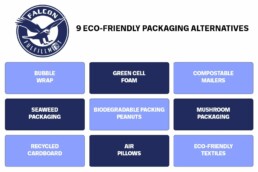
Test Your Packaging Before Shipping
It might seem silly to package a product and then drop it off a 4ft cliff, but that is precisely what can make the difference between a refund and a 5-star review. Put your packaging to the test by shaking it, dropping it, banging it, rolling it, vibrating it, and torturing it as many ways as possible. If your product maintains pristine quality after rigorous trials, you can be assured your product should arrive with minimal shipping damage.
Use Quality Sealing Tape or Adhesive
Select high-quality sealing tape that is rated to hold the weight of your product. Also, ensure all edges are aligned and sealed fully to prevent snags.
Inspect Regularly
From the receiving dock to the final mile delivery it is important to document damage and shortages. Keeping a record of manufacturing damage can help you work with your vendor to modify shipping or packaging to minimize damage. Furthermore, if you are using a carrier that consistently delivers packages that are sustaining damage it can tell you it’s time to change. Track damage sustained including images of damage through the entire fulfillment process.
Extermination
Keeping a regular schedule of extermination in your storage and warehousing facility is crucial to keep pests away. Limiting access points and sealing all food items well will also keep from attracting bugs, beetles, and flies. It isn’t possible to keep pests from entering an open door but you can minimize shipping damage from them by ensuring you exterminate regularly and seal boxes fully.
Beginner’s Guide to Third-Party Logistics (3PL)
The world of e-commerce is always changing, therefore understanding the roll of Third-Party Logistics is integral to keeping up. In light of this our beginner’s guide to third-party logistics (3PL) will delve into the essential aspects, offering insights into fulfillment services, warehousing, and much more.
Read More…
The main causes of e-commerce shipping damage are not difficult to prevent but they do require attention to detail. Many e-commerce business owners have restricted time and energy to focus on ensuring they have the best possible packaging, materials, and inspection procedures. This is why partnering with a fulfillment expert like Falcon Fulfillment can help minimize shipping damage. Not only can we select the best shipping options for your product but we also ensure the highest quality standards for handling, cleanliness, and accuracy.
Get in touch today to see how we can help save you money on shipping damage returns.
Let’s Talk!
Expanding Your Network with a 3PL
Expanding Your Network with a 3PL
3PL partners offer logistics services and supply chain management. They are logistics experts, specifically; warehousing, picking and packing, inventory management, transportation, fulfillment, packaging, and returns management. Because of the focused nature of a 3PL, they typically have a broad network of partners related to all aspects of the logistics industry. How can you expand your network with a 3PL?
Transportation Network

3PLs boast relationships with multiple carriers spanning the transportation industry. These partnerships extend to various van lines, shipping companies, freight carriers, and rail lines. While an individual e-commerce business might maintain personal connections with one or two carriers, a 3PL cultivates relationships with numerous providers. The significance for your business lies in the immediate access to this expansive transportation network. This accessibility proves invaluable in scenarios such as unexpected disruptions, like flooding in Missouri, which may impede travel through vital interchanges. In such instances, your 3PL can swiftly pivot to alternative providers and routes, ensuring minimal delays.
Legal

A viable rats nest of legal concerns surround logistics, especially when you involve international shipments. This includes complicated issues like documentation, import and export regulations, as well as economic regulations. Hiring or investigating the nuances of international logistic law is time-consuming and expensive. One of the most cost-effective ways to expand your legal network is through partnering with a 3PL. A 3PL already has the expertise and relationships to comply with local, federal, and international laws. Your 3PL will have a pulse on the ever-changing legal fulfillment battles—especially those tricky wine and beer fulfillment issues.
Expand to New Locations

Expanding your e-commerce reach to new locations is daunting when you don’t have an on-the-ground expert helping you. When you consider trying to expand to new locations, you start by evaluating the market, estimating inventory needs, training staff, and sourcing suppliers and distributors. It is a very involved process. A 3PL expands your network by aiding in providing staff, multi-site distribution space, and flexible warehousing space as your reach grows. Not only that, but 3PL companies have a broad network of suppliers they work with and can make mutually beneficial introductions.
Returns Management
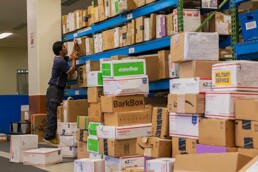
One of the greatest deterrents to gaining loyal customers is a lack of responsive customer service or a complex returns process. While most businesses would like to avoid returns altogether, having a solid return management process is crucial. Some of the best 3PL partnerships help manage the returns process, including receiving, returning items to the inventory management system, and disposing of damaged goods. 3PLs are experts in streamlining the returns process and ensuring a good customer experience.
Beginner’s Guide to Third-Party Logistics (3PL)
The world of e-commerce is always changing, therefore understanding the roll of Third-Party Logistics is integral to keeping up. In light of this our beginner’s guide to third-party logistics (3PL) will delve into the essential aspects, offering insights into fulfillment services, warehousing, and much more.
Read More…
By expanding your network with a 3PL, you can effectively scale your growing e-commerce venture. Moreover, this strategic move offers a cost-effective solution to your expansion needs. From streamlining transportation to ensuring legal compliance, partnering with a 3PL becomes crucial, especially if you lack an extensive network in these industries. At Falcon Fulfillment, we’ve cultivated robust relationships spanning transportation, legal, and marketing sectors, complemented by a multi-site distribution framework.
We are poised and ready to help you expand your network and business! Get in touch with one of our agents today.
Let’s Talk!
Improving Supply Chain Resilience with a 3PL Partner
Improving Supply Chain Resilience with a 3PL Partner
The supply chain is often taken for granted until it is broken. The supply chain revealed some critical areas of weakness thanks to COVID-19 and the dominoes that toppled afterward. Improving supply chain resilience became an instant focus. Mike Jackson, executive director at the Original Equipment Suppliers Association (OESA), says, “Supply chain risks spiked on a number of fronts, fueled by workforce constraints, input shortages, and liquidity issues, due to the slashing of production volumes and future forecasts.” Companies scrambled with little or no notice to meet growing customer demands and plummeting supply.
During one of the biggest e-commerce booms, the businesses that thrived deployed partnerships and processes that improved supply chain performance. Delays, disruptions, and ongoing issues in the supply chain will not be dissolving anytime soon. This article will discuss why partnering with a 3PL is critical in improving supply chain resilience.
What are the supply chain risks?

Long Lead Times
The time it takes from an order placed to an order delivered to the consumer dramatically increased in 2020. According to a report by Anvyl, the top five reasons for the long lead times were:
- Lack of containers
- COVID-related issues (shutdowns, outbreaks, curfews, sick workforce)
- Vessel space constraints
- Raw material delays
- Awaiting information from buyer (mostly payment delays)
Longer lead times cost many e-commerce customers. Even global conglomerate Amazon struggled to meet its “prime effect” two-day shipping. When a customer makes a purchase, they want it on their doorstep in hours or days. With the pandemic easing and the supply chain recovering, customer tolerance for delays is eroding.

Raw Material Shortages
Several ongoing factors are still contributing to a raw materials shortage, including geopolitical issues, continued zero COVID policy in China, and an upsurge in prices for raw goods. The Russian-Ukrainian crisis increased fuel costs and limited mobility of materials to major export partners. The dramatic knock-on effect left global and domestic manufacturing plants scrambling to source new suppliers. A few key industries have been hit the hardest, including; textiles, footwear, electronics, and agriculture.
Lack of Diversification
Diversification is crucial in improving supply chain resilience. From suppliers to consumer delivery routes, a diversified supply chain will increase the likelihood of success. The most pronounced areas are suppliers and manufacturing, transportation, and distribution.
Lack of Visibility
Do these phrases sound familiar, “Out of stock, back ordered, delayed shipment, delivery canceled?” The likelihood you have received this as a consumer is high. If you are an e-commerce business owner, the possibility you just had a moment of anxiety reading those is higher. Once the supply chain dominoes began to topple, the transparency of how goods were moving through the supply chain became uncertain and imprecise.
Customer service teams were overwhelmed with calls from frustrated consumers who just wanted to know WHEN or IF the product they purchased over ten days ago would arrive. Unfortunately, many businesses didn’t have a confident response. The limitations in supply chain visibility became evident. Companies that leveraged person-to-person communications and technology to illuminate issues within the supply chain could give consumers more details. Even though they may have had significant delays, they could communicate with customers proactively.
How to Improve Supply Chain Resilience with a 3PL Partner
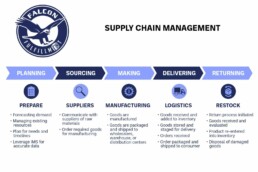
Improving Long Lead Times
While a 3PL cannot make your manufacturer produce products any faster, they can assist with the long lead times by offering flexible warehousing. Even though lead times from international manufacturers might still be 6-8 months, the lead time from order to consumer can become significantly shorter. Having a scalable amount of storage based on fluctuating consumer demand allows e-commerce brands to pre-order products.
Improving Diversification
This is where a 3PL partnership can make the most significant improvement in supply chain resilience. Third-Party-Logistics providers are experts in transportation, manufacturers, and distribution. Where an individual e-commerce may have relationships with a few van lines or shipping suppliers, a 3PL has a vast network of connections across the transportation sector. A 3PL poised to improve your supply chain resilience will have relationships spanning air, ocean, and land. This is critical when one transportation supplier cannot deliver based on illness, staffing shortages, or border/port closures. A quick pivot can be managed by your 3PL partner, which will reduce delays.
Second to transportation is the manufacturing sector. A solid 3PL can make introductions across suppliers in order to diversify. E-commerce companies reliant on one manufacturer were at their mercy. 3PLs can help locate and work with suppliers to mitigate the risk of stockouts.
Lastly, ensuring multi-site distribution and warehousing is key in diversifying your supply chain. The best 3PL partners offer multiple warehouses where products are received, pick-and-packed, labeled, and shipped. During the worst of the slow-downs in the ports, there were certain products that were moving through West coast ports better than East coast ports and vice versa. It was highly beneficial to have a partner that could receive products from either coast. Furthermore, having a distribution warehouse near domestic manufacturers was a game-changer.

Improving Visibility
Communication failures, confusion, and limited insight from the supply chain became commonplace. However, 3PL teams are adept at reading insights and proactively determining when supplies would become critically low. Partnering with a solid 3PL allows for detailed reporting on inventory levels, forecasting, and even managing customer returns. From receiving to final delivery, a 3PL can provide almost real-time insight into your business. Premiere 3PL providers will also offer a personal approach with dedicated account managers you can contact directly. Having insight into when, where, and how your products are being managed equips your team with the information they need to appease frustrated consumers.
Beginner’s Guide to Third-Party Logistics (3PL)
The world of e-commerce is always changing, therefore understanding the roll of Third-Party Logistics is integral to keeping up. In light of this our beginner’s guide to third-party logistics (3PL) will delve into the essential aspects, offering insights into fulfillment services, warehousing, and much more.
Read More…
The supply chain is improving slowly. Businesses that stand to survive and thrive as disruptions continue to leverage every asset they can to improve supply chain resilience. By partnering with a solid 3PL, you can improve visibility, diversify transportation and distribution, expand manufacturing relationships, and decrease lead times. 3PL partners are logistics experts that can leverage their relationships to improve your business’s supply chain resilience.
Want to learn more about how Falcon Fulfillment can improve your supply chain KPIs and create a more resilient process? Talk to one of our agents today.
Let’s Talk!
How Tariffs Impact E-commerce Profits and the 3PL Solutions
How Tariffs Impact Ecommerce Profits and Why 3PLs Are the Solution
In 2025, ecommerce businesses face a daunting challenge: new tariffs are squeezing profit margins tighter than ever. Whether you’re importing goods from overseas or navigating rising shipping costs, tariffs impact ecommerce in ways that demand smarter strategies. Fortunately, Third-Party Logistics (3PL) providers offer a lifeline. By leveraging their expertise in fulfillment services and supply chain management, businesses can stay competitive. Let’s explore how tariffs impact ecommerce, why margins are at risk, and how outsourcing to a 3PL can help you thrive.
The Tariff Threat to Ecommerce
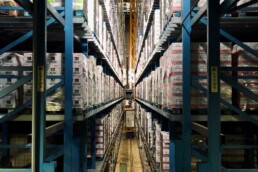
Tariffs, essentially taxes on imported goods, have been a hot topic since the U.S.-China trade war began adding billions in costs—$80 billion since 2018, according to the USTR. In 2025, with potential tariff hikes looming (think 10-20% on Chinese goods), ecommerce companies feel the pinch. For instance, higher costs for inventory mean slimmer profits unless prices rise—which risks losing price-sensitive customers. Meanwhile, shipping and delivery expenses climb as fuel surcharges and carrier fees reflect tariff-driven inflation. Tariffs impact ecommerce not just at the product level but across the entire supply chain.
However, the story doesn’t end there. Businesses relying on international shipping and import/export face delays at customs, while last-mile delivery costs soar—often accounting for over 50% of total delivery expenses, per 2024 Pitney Bowes data. Without a plan, these pressures erode profitability fast. So, what’s the solution?
How 3PLs Counter Tariff Challenges
This is where Third-Party Logistics (3PL) steps in. By outsourcing to a 3PL, ecommerce businesses tap into scalable fulfillment solutions that offset tariff costs. For example, 3PLs excel at supply chain optimization, using tools like warehouse automation and cloud-based Warehouse Management Systems (WMS) to streamline operations. Instead of absorbing higher freight costs, a 3PL’s freight rate negotiation and carrier selection and management can secure better deals. Consequently, you save money without compromising on-time delivery.
Moreover, 3PLs offer warehousing and distribution closer to your customers. Imagine storing inventory in a U.S.-based fulfillment center rather than relying solely on overseas bulk shipping. This reduces international shipping fees and customs brokerage headaches, directly countering how tariffs impact ecommerce. At Falcon Fulfillment, for instance, our Salt Lake City and Louisville hubs enable 2-day ground shipping to most of the U.S.—a cost-effective edge in a tariff-heavy world.

Practical Cost-Saving Strategies with 3PLs
Beyond location, 3PLs bring value-added services (VAS) like kitting and assembly or packaging optimization. These boost order value and cut waste, helping you maintain margins without raising prices. Additionally, inventory management becomes a breeze with 3PL technology solutions—think inventory tracking software and order fulfillment metrics and reporting. By forecasting demand and using inventory cycle counts, you avoid overstocking costly tariffed goods.
For multi-channel fulfillment, 3PLs integrate seamlessly with platforms like Shopify, ensuring order accuracy and quality control across sales channels. Meanwhile, services like reverse logistics and Return Merchandise Authorization (RMA) processing keep returns efficient, preserving customer trust. In short, a 3PL turns tariff challenges into opportunities by optimizing every step from order fulfillment solutions to transportation management systems (TMS).
Why Outsourcing Makes Sense Now

Although managing fulfillment in-house might feel like control, tariffs expose its limits. Rising costs for freight forwarding, outbound and inbound logistics, and even same-day and next-day delivery strain small teams. On the other hand, a 3PL’s expertise in ecommerce fulfillment and freight consolidation spreads those costs across their network, delivering savings you can’t replicate alone. Plus, with 3PLs handling order tracking and management, you focus on growth—not logistics.
Consider this: as tariffs impact ecommerce, profit margins shrink unless you adapt. A 3PL partnership might just be the edge you need to keep prices competitive and customers happy. It’s not about handing over control; it’s about leveraging pros who’ve mastered fulfillment cost analysis and supply chain management. At Falcon, we’ve seen clients cut shipping costs by 15% through strategic warehousing—proof that outsourcing works.
Beginner’s Guide to Third-Party Logistics (3PL)
The world of e-commerce is always changing, therefore understanding the roll of Third-Party Logistics is integral to keeping up. In light of this our beginner’s guide to third-party logistics (3PL) will delve into the essential aspects, offering insights into fulfillment services, warehousing, and much more.
Read More…
Ultimately, tariffs are here to stay, reshaping how ecommerce operates. However, with the right partner, you can navigate this storm. A 3PL offers more than just order fulfillment solutions; it’s a strategic ally against rising costs.
So, if tariffs impact ecommerce profits at your business, why not explore what outsourcing can do? The savings—and peace of mind—might surprise you.
Let’s Talk!
Ways to Reduce Inventory Shrinkage
Ways to Reduce Inventory Shrinkage
What is inventory shrinkage? How does it affect your bottom line? What is an acceptable percentage of inventory shrinkage? How can I prevent it?
Inventory shrinkage occurs when the physical inventory levels do not match the accounting records. The accounting data says you should have a specific number of physical products available, but after an actual count, a difference exists. No matter the inventory management systems or processes you have in place, shrinkage will occur.
Many reasons cause shrinkage, from human errors to theft. Inventory shrinkage affects retailers’ bottom line. According to the National Retail Security Survey, inventory shrinkage accounted for 1.38% of all retail sales. This represents a significant loss of revenue for retailers and e-commerce businesses. This article will discuss the leading causes of inventory shrinkage, how to calculate it, and ways to reduce shrinkage.
Causes of Inventory Shrinkage
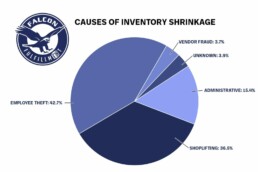
Employee Theft
Employee theft accounts for nearly 42.7% of all inventory shrinkage. Whether from a brick-and-mortar shop or the warehouse, human beings are the most significant threat to increasing inventory shrinkage. Petty theft is stealing something that doesn’t have a high value. Taking a few pens, copy paper, or a coffee mug from the office isn’t a big deal, right? It becomes a big deal when you have 300 employees doing the same thing. Bolder employees find ways to steal much higher ticket items.
Skimming fraud is another form of theft that is much more challenging to detect. Employees pocket cash payments without ever adding the transaction to the system. This is where regular audits come in handy. Whether your staff is committing petty theft or skimming fraud, all forms of employee theft will adversely affect your bottom line.
Shoplifting
The ugly step-cousin of employee theft is consumer theft. Shoplifting has become a greater risk in the post-pandemic era due to staffing shortages across all retail outlets. The U.S. Chamber of Commerce discovered that employees quitting retail are only outpaced by the Leisure and Hospitality industries. Currently, less staff are responsible for managing more square footage in almost every retail outlet. According to a report released by the Council on Criminal Justice, shoplifting accounts for the largest portion of thefts next to motor vehicles. With less staff, it means fewer eyes watching and profiling potential shoplifters.
Administrative
Human error is another cause of inventory shrinkage. Albeit less than employee theft, it is still significant. Reporting errors, data input errors, and problems reconciling the accounts contribute to administrative inventory shrinkage.
Vendor Fraud
Vendor fraud occurs when the vendor or manufacturer sends a different amount of inventory than is stated on the invoice. This is relatively easy to spot when you only receive 10-20 boxes in a shipment. It becomes almost impossible when your shipments are 100s of packages.
Lost Shipments
Misplaced goods or lost shipments are another one of the most common causes of inventory shrinkage. Busy distribution and fulfillment centers are loading and unloading thousands of parcels a day. Warehouse crews move pallets from receiving to their warehousing space quickly to make room for the next shipment. Most shipments receive proper barcodes and are stored properly. However, some packages loose their barcode, are mislabeled, or are improperly stored. That package is lost.
Reducing Inventory Shrinkage
In fiscal year 2020, over 15% of retailers in the United States stated that they experienced an inventory shrink of 3% and higher.
Calculate Inventory Shrinkage Rate
Before reducing your shrinkage, you need to know how to calculate it. The acceptable level of shrinkage is less than 1%, but many companies experience much higher levels. Here is the industry formula for calculating your inventory shrinkage rate.

One of the major contributors to reducing inventory shrinkage is simply measuring it. You cannot fix what you don’t know is a problem! Once you have a baseline rate, you can implement the following processes to measure accurately and reduce inventory shrinkage effectively.
Track Every Item – Barcode and SKU
Every product must possess a unique identifier. This empowers inventory management systems to effectively track in real-time. It furnishes the data to promptly pinpoint inventory shrinkage and gain insight into where products are losing or getting stolen. Many fulfillment companies and suppliers have the capability to attach unique barcodes or SKUs to products before or during the receiving process. This decreases human error and enhances the capability to track inventory as it progresses through the sales process.
Train Employees
Certainly, you will instruct your employees in performing their duties, but it’s essential to provide targeted training on employee theft. Establish a clear policy and procedure concerning theft. Clearly define the repercussions for theft and its detrimental impact on the company. Introduce a mechanism for employees to anonymously report suspected theft. Clearly communicate what constitutes theft and the threshold at which termination or legal action will be pursued. Ensure that all employees grasp the expected standards.
Use Automated Inventory Management Systems
Having a single point of truth regarding inventory levels is key to reducing inventory shrinkage. Managing all available products through a uniform system ensures accurate and up-to-date data. Administrative errors are reduced when information is not transferred from one system to another. Barcodes and SKUs have the exact details in North Dakota as they do in the warehouse in Salt Lake City. Automated inventory management systems unify the data across the fulfillment and final sales exchange.
Enhanced Security Measures

Because so much inventory shrinkage is attributed to theft, increasing security measures is an excellent way to reduce it. Install cameras throughout your retail space, behind the cash register, store room, and loading dock to prevent theft. Give each employee a unique login to track voided cash transactions and irregular sales patterns. Also, consider hiring a security guard, especially for high-value items or when you notice an increase in theft in a specific area. Don’t forget about your warehouse or distribution locations. If you outsource fulfillment, ensure your partner has 24/7 security, cameras, and a regular schedule of reviewing employees.
Surprise Audits and Consistent Tracking
Surprise! Checking your inventory levels regularly and unexpectedly helps reduce inventory shrinkage. Surprise audits minimize theft and highlight admin errors regularly. When you commit to periodically updating inventory levels in real-time, you will identify the main issues, and you can begin to reduce the impact.
Partner with an Excellent 3PL
Partnering with an excellent 3PL can provide your business with many of the solutions listed here. They leverage automated inventory management systems that can provide real-time stock levels. They invest in serious security measures, including cameras, on-site security, and thorough employee training. Furthermore, a great 3PL can help implement barcoding for every SKU that syncs to the IMS. Their receiving crews are trained with double-check systems to reduce lost or misplaced products. Lastly, vendor fraud is minimized by providing accurate and detailed receiving reports. Working with Falcon Fulfillment would be a great option!
Beginner’s Guide to Third-Party Logistics (3PL)
The world of e-commerce is always changing, therefore understanding the roll of Third-Party Logistics is integral to keeping up. In light of this our beginner’s guide to third-party logistics (3PL) will delve into the essential aspects, offering insights into fulfillment services, warehousing, and much more.
Read More…
Inventory shrinkage is an unfortunate reality, but it can be managed. At Falcon Fulfillment, we understand that every dollar counts when growing and building a business.
Want to learn more ways to reduce inventory shrinkage for your company? Get in touch today.
Let’s Talk!








